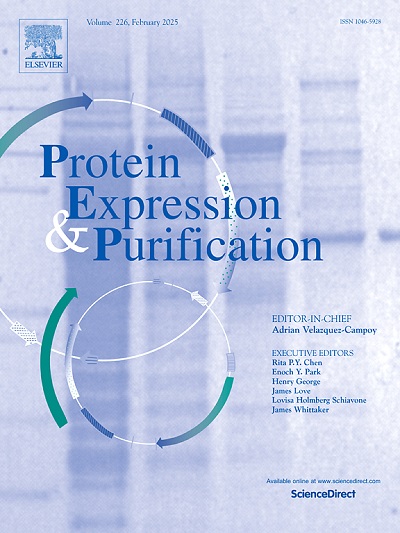用于SIGLEC-15检测的纳米体的筛选和制备。
IF 1.2
4区 生物学
Q4 BIOCHEMICAL RESEARCH METHODS
引用次数: 0
摘要
作为Siglec家族的重要成员,Siglec -15在破骨细胞分化、骨重塑、肿瘤免疫逃避等方面发挥重要作用。在肿瘤微环境中,SIGLEC-15独立于B7-H1/PD-1通路发挥作用。本研究利用真核表达系统成功表达并纯化了SIGLEC-15融合蛋白(SIGLEC-15- fc)。该蛋白随后被用作免疫骆驼的抗原,诱导产生针对SIGLEC-15的特异性纳米体(vhs)。所得纳米体分子量约为15 kDa。经过筛选,我们鉴定出两种纳米体菌株Nb1C8和Nb2D7,它们都能与SIGLEC-15无竞争结合。我们通过Octec平台和稳定性分析证实了纳米体的高亲和力和稳定性。流式细胞术分析表明,Nb1C8和Nb2D7特异性结合膀胱癌细胞上天然表达的SIGLEC-15。该研究标志着靶向SIGLEC-15的纳米体的首次开发,为开发与SIGLEC-15相关的诊断工具和抗体疗法提供了坚实的基础。本文章由计算机程序翻译,如有差异,请以英文原文为准。
Screening and preparation of nanobodies for SIGLEC-15 detection
As an important member of the Siglec family, SIGLEC-15 plays an important role in osteoclast differentiation, bone remodeling, and tumor immune evasion. In the tumor microenvironment, SIGLEC-15 functions independently of the B7-H1/PD-1 pathway. In this study, the SIGLEC-15 fusion protein (SIGLEC-15-Fc) was successfully expressed and purified using a eukaryotic expression system. This protein was then used as an antigen to immunize camelids, inducing the production of specific nanobodies (VHHs) targeting SIGLEC-15. The resulting nanobodies exhibited a molecular weight of approximately 15 kDa. After screening, we identified two nanobody strains, Nb1C8 and Nb2D7, both of which bind SIGLEC-15 without competition. We confirmed the nanobodies’ high affinity and stability through Octec platform and stability analyses. Flow cytometry analysis demonstrated that Nb1C8 and Nb2D7 specifically binds to SIGLEC-15 which naturally expressed on bladder cancer cells. This study marks the first development of nanobodies specifically targeting SIGLEC-15, providing a solid foundation for the development of SIGLEC-15-related diagnostic tools and antibody therapeutics.
求助全文
通过发布文献求助,成功后即可免费获取论文全文。
去求助
来源期刊

Protein expression and purification
生物-生化研究方法
CiteScore
3.70
自引率
6.20%
发文量
120
审稿时长
32 days
期刊介绍:
Protein Expression and Purification is an international journal providing a forum for the dissemination of new information on protein expression, extraction, purification, characterization, and/or applications using conventional biochemical and/or modern molecular biological approaches and methods, which are of broad interest to the field. The journal does not typically publish repetitive examples of protein expression and purification involving standard, well-established, methods. However, exceptions might include studies on important and/or difficult to express and/or purify proteins and/or studies that include extensive protein characterization, which provide new, previously unpublished information.
 求助内容:
求助内容: 应助结果提醒方式:
应助结果提醒方式:


